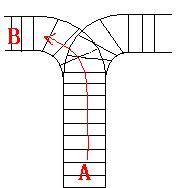


查看此图便会很容易的理解什么是栈了——就是只有一个入口(封闭的容器),所以栈的特点就是先进后出,或者后进先出。
提到栈,不得不提指针,进栈时先移指针后进栈,出栈时先出栈后移指针。
下面要说的,此堆非彼堆:
栈的优势是,存取速度比堆要快,仅次于直接位于CPU中的寄存器。但缺点是,存在栈中的数据大小与生存期必须是确定的,缺乏灵活性。另外,栈数据可以共享。堆的优势是可以动态地分配内存大小,生存期也不必事先告诉编译器,Java的垃圾收集器会自动收走这些不再使用的数据。但缺点是,由于要在运行时动态分配内存,存取速度较慢。
另说下java中==和equals的区别,也加深对栈和堆的理解
==比较的是两个对象的栈中的数据,比较的是基本数据类型的内容;而equals比较的是堆中的数据,比较的是引用数据类型的地址。
HDU1022 详见
http://acm.hdu.edu.cn/showproblem.php?pid=1022
java中有栈的类库,java.util.Stack;此类库中就有5个方法,简单实用记住就好
Ⅰ.empty() 测试堆栈是否为空,返回boolean值
Ⅱ.peek() 查看堆栈顶部的对象,但不会从堆栈中移除
Ⅲ.pop() 移除并返回堆栈顶部的对象
Ⅳ.push(E e) 把项压入堆栈顶部
Ⅴ.search(Object o) 返回对象在堆栈中的位置(int型),以1为基数
import java.util.*;
public class Main
{
public static void main(String[] args)
{
Scanner scan=new Scanner(System.in);
while(scan.hasNext())
{
int n=scan.nextInt();
int index1=0,index2=0,k=0;
boolean[] judge=new boolean[18];
String init=scan.next();
String comp=scan.next();
Stack<Character> st=new Stack<Character>();
int temp=1;
while(index2<n)
{
if(!st.empty()&&st.peek().equals(comp.charAt(index2)))
{
judge[k++]=false;
st.pop();
index2++;
}
else if(index1<n)
{
judge[k++]=true;
st.push(init.charAt(index1));
index1++;
}
else{
temp=0;
break;
}
}
if(temp==1)
{
System.out.println("Yes.");
for(int w=0;w<k;w++)
{
if(judge[w])
System.out.println("in");
else
System.out.println("out");
}
}
else
System.out.println("No.");
System.out.println("FINISH");
}
}
}
分享到:




相关推荐
HDU 1022 Train Problem I 附详细思路
HDU的1250,主要是利用高精度加法,但是代码有点繁琐,效率不是很高
杭电ACMhdu1163
HDU1059的代码
hdu1001解题报告
hdu 1574 passed sorce
HDU的一题........HDU DP动态规
hdu acm 教案 搜索入门 hdu acm 教案 搜索入门
hdu2101AC代码
搜索 dfs 解题代码 hdu1241
hdu 5007 Post Robot 字符串枚举。 暴力一下就可以了。
hdu acm 教案 动态规划(1) hdu acm 教案 动态规划(1)
ACM HDU题目分类,我自己总结的大概只有十来个吧
hdu 1166线段树代码
HDU最全ac代码
hdu动态规划算法集锦
自己做的HDU ACM已经AC的题目
hdu题目分类
HDU图论题目分类
Problem Description The least common multiple (LCM) of a set of positive integers is the smallest positive integer which is divisible by all the numbers in the set. For example, the LCM of 5, 7 and 15...